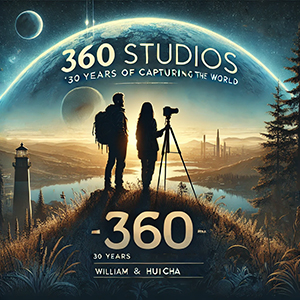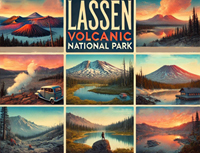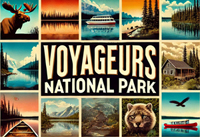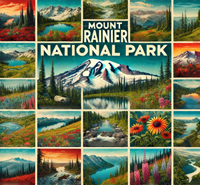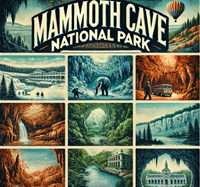

Embark on a journey curated by seasoned explorers William and Hui Cha Stanek, who have spent decades immersing themselves in the diverse landscapes of North America. These itineraries are more than just travel plans - they are thoughtfully crafted adventures designed to help you connect with the natural world, discover hidden gems, and create lasting memories.
National Parks Index | US Itineraries Index | American Roadtrips Index

Bring home a Bugville Critters book and watch as your child's love for reading and learning grows with every page. Hand-painted illustrations bring the heartwarming stories to life. Ask your librarian to add Bugville Critters to the library's digital collection today!
Discover William Stanek's Exclusive Art Collection
Explore and purchase the stunning art featured on this site. Own a piece of William Stanek's unique and captivating artwork today!
(January 28, 2025) Deep Exploration of Everglades and Biscayne National Parks
A 3-day Adventure
Personal Story: William's First Encounter with the Everglades
Entering the Everglades, I was both thrilled and a little uneasy. Growing up in the Midwest, I was more accustomed to forests and mountains than the flat, watery expanse of this unique ecosystem. Yet, as soon as I stepped into the park, I was captivated. The Everglades, with its slow-moving waters, sawgrass prairies, and rich biodiversity, felt like stepping into another world – one where nature ruled and time moved at a different pace. I remember standing on the boardwalk at the Anhinga Trail, watching an alligator glide silently through the water below, while birds called out from the surrounding marshes. It was a place of stillness and raw beauty, where every step brought a new discovery. Returning here with Hui Cha, we found that the Everglades and nearby Biscayne National Park offer an extraordinary adventure, rich with history, wildlife, and the serenity that only such untouched places can provide.
About Everglades National Park
The Everglades, often referred to as the "River of Grass," is a vast network of slow-moving water that covers much of southern Florida. This unique ecosystem, designated a UNESCO World Heritage Site, is home to an incredible array of wildlife, including alligators, manatees, and hundreds of bird species. Established as a national park in 1947, the Everglades is the largest subtropical wilderness in the United States, offering visitors a glimpse into a world where water, sky, and land merge into one.
For those who have more time to delve into the unique ecosystems of South Florida, a three-day itinerary offers the opportunity to fully immerse yourself in the natural beauty and rich biodiversity of Everglades and Biscayne National Parks. This itinerary will guide you through the highlights of each park, while also providing off-the-beaten-path experiences that showcase the quieter, more intimate side of these remarkable destinations.
Day 1: Exploring the Heart of the Everglades
Morning: Shark Valley and the Observation Tower
7:00 AM - Begin at Shark Valley Visitor Center
Overview: Start your three-day adventure in the northern section of the Everglades at Shark Valley. This area is known for its incredible wildlife viewing opportunities and the scenic Shark Valley Tram Trail, which offers a unique perspective of the park's vast sawgrass prairies.
Tips from William: "Shark Valley is one of my favorite places to start the day in the Everglades. The early morning light is perfect for wildlife photography, and the 15-mile loop trail offers plenty of chances to see alligators, birds, and other wildlife. If you're up for it, rent a bike and ride the loop – it's a fantastic way to experience the park."
Insights from Hui Cha: "The Shark Valley Observation Tower, located halfway along the loop, offers stunning panoramic views of the Everglades. The climb to the top is gentle, and the 360-degree view is well worth the effort. Bring a pair of binoculars to spot wildlife in the distance."
How to Access Shark Valley Visitor Center
Location: The Shark Valley Visitor Center is located about 40 miles west of Miami along U.S. Highway 41 (Tamiami Trail).
Directions: From Miami, take U.S. Highway 41 (Tamiami Trail) west for approximately 40 miles. Look for signs for the Shark Valley entrance on your left.
Trail Details: The Shark Valley Tram Trail is a 15-mile loop that can be explored on foot, by bike, or by tram tour. The trail is flat and paved, making it accessible for all visitors. Bikes can be rented at the visitor center, and tram tours are available for those who prefer a more relaxed experience.
Photography Techniques:
-
Wildlife Close-Ups: Use a telephoto lens (200mm or longer) to capture close-ups of alligators, birds, and other wildlife along the trail. Early morning is the best time to see animals actively moving and feeding.
-
Wide-Angle Landscapes: The view from the Shark Valley Observation Tower is perfect for wide-angle shots that capture the vastness of the Everglades. Use a polarizing filter to reduce glare and enhance the colors of the sky and water.
-
Panoramic Views: The Observation Tower offers a 360-degree view of the surrounding landscape, making it an ideal spot for panoramic photography. A wide-angle lens will help you capture the full expanse of the sawgrass prairies and distant tree islands.
Alternative Activity:
If biking 15 miles feels like too much, consider taking the Shark Valley Tram Tour. This guided tour provides a comprehensive overview of the area's history, ecology, and wildlife, with plenty of stops for photos along the way. It's a great option for families or those who prefer a more leisurely pace.
Mid-Morning: Loop Road Scenic Drive
10:30 AM - Explore the Loop Road Scenic Drive
Overview: After your morning at Shark Valley, take a scenic drive along Loop Road, a gravel road that winds through the Big Cypress National Preserve, a neighboring area rich with wildlife and stunning landscapes. This lesser-known route offers a quieter, more intimate experience of the Everglades ecosystem.
Tips from William: "Loop Road is a hidden gem in the Everglades. The drive takes you through dense cypress forests, open prairies, and along quiet waterways, where you're likely to spot alligators, turtles, and wading birds. Keep your camera ready and drive slowly – there are plenty of pull-offs where you can stop to take photos or just soak in the scenery."
Insights from Hui Cha: "The slow pace of this drive allows you to really appreciate the beauty of the Everglades. The cypress trees, draped with Spanish moss, create a serene and almost mystical atmosphere. Be sure to bring plenty of water and snacks, as there are no services along the road."
How to Access Loop Road
Location: Loop Road is located off U.S. Highway 41 (Tamiami Trail), near the eastern entrance to Big Cypress National Preserve.
Directions: From Shark Valley, head west on U.S. Highway 41 (Tamiami Trail) for about 5 miles. Look for signs for Loop Road on your left. The road is gravel but well-maintained, and suitable for most vehicles.
Drive Details: Loop Road is approximately 24 miles long and takes about 1.5 to 2 hours to drive, depending on how often you stop. The road is narrow and winding, with numerous pull-offs where you can stop to explore the area on foot or take photographs.
Photography Techniques:
-
Cypress Swamp Reflections: The still waters along Loop Road create beautiful reflections of the cypress trees and Spanish moss. Use a polarizing filter to enhance these reflections and reduce glare.
-
Wildlife Photography: Keep your telephoto lens ready to capture close-ups of alligators, birds, and other wildlife that frequent the area. The slow pace of the drive allows for plenty of opportunities to spot and photograph animals.
-
Detail Shots: The dense vegetation along Loop Road is full of interesting details, from the textures of the cypress bark to the delicate patterns of the Spanish moss. Use a macro lens to capture these close-up details.
Alternative Activity:
If you prefer to stay on foot, consider hiking the nearby Kirby Storter Roadside Park Trail. This short boardwalk trail takes you through a cypress dome and offers excellent wildlife viewing opportunities. The trail is just off U.S. Highway 41 and is a great option for a quick, yet rewarding, nature walk.
Afternoon: Big Cypress Bend Boardwalk
1:00 PM - Walk the Big Cypress Bend Boardwalk
Overview: After your scenic drive, stretch your legs on the Big Cypress Bend Boardwalk, a peaceful trail that takes you deep into the heart of the cypress swamp. This boardwalk is one of the best places to experience the quiet beauty of the Everglades' swamp ecosystem.
Tips from William: "The Big Cypress Bend Boardwalk is a fantastic spot for nature photography. The towering cypress trees, the dense undergrowth, and the occasional sighting of an alligator or bird make this a rewarding hike. The light filtering through the trees can be magical, especially in the afternoon."
Insights from Hui Cha: "This boardwalk is a hidden oasis of tranquility. The sounds of the swamp, the rustle of leaves, and the occasional call of a bird make it a perfect place to relax and connect with nature. Bring a hat and plenty of water – the shade offers some relief from the sun, but it can still be warm."
How to Access Big Cypress Bend Boardwalk
Location: The Big Cypress Bend Boardwalk is located in the Fakahatchee Strand Preserve State Park, just off U.S. Highway 41.
Directions: From Loop Road, continue west on U.S. Highway 41 for about 20 miles. Look for signs for the boardwalk on your left, where you'll find a small parking area and the trailhead.
Trail Details: The Big Cypress Bend Boardwalk is a 1.2-mile round trip trail that winds through a cypress swamp. The trail is flat and accessible, making it suitable for all ages and abilities.
Photography Techniques:
-
Vertical Compositions: The tall cypress trees and the vertical lines of the boardwalk make for striking compositions. Use a wide-angle lens to capture the height and grandeur of the trees.
-
Low-Light Photography: The dense canopy can create low-light conditions, so bring a tripod to stabilize your camera for longer exposures. This will help you capture the rich greens of the swamp without blur.
-
Wildlife and Detail Shots: The boardwalk is a great place to spot birds, alligators, and other wildlife. Use a telephoto lens for wildlife shots, and a macro lens to capture the intricate details of the vegetation.
Alternative Activity:
If you prefer a more adventurous hike, consider exploring the nearby Jane's Scenic Drive and the associated trails in the Fakahatchee Strand Preserve. These less-traveled paths offer a wilder experience of the Everglades, with opportunities to see rare plants, birds, and even panthers if you're lucky.
Evening: Sunset at Chokoloskee Bay
6:00 PM - Sunset at Chokoloskee Bay
Overview: End your day with a sunset over Chokoloskee Bay, a quiet and picturesque area on the western edge of the Everglades. The bay is known for its beautiful views and peaceful atmosphere, making it the perfect place to relax and reflect on your day.
Tips from William: "Chokoloskee Bay is a fantastic place for sunset photography. The bay's calm waters reflect the colors of the sky, creating stunning compositions. Use a tripod for long exposures as the light fades, and consider bringing a graduated neutral density filter to balance the exposure between the bright sky and the darker water."
Insights from Hui Cha: "There's something special about watching the sunset over the water, with the sound of the bay lapping at the shore. Bring a blanket or a camping chair and make yourself comfortable – it's a peaceful way to end a day of exploring the Everglades."
How to Access Chokoloskee Bay
Location: Chokoloskee Bay is located just south of Everglades City, on the western edge of Everglades National Park.
Directions: From Big Cypress Bend, head west on U.S. Highway 41, then turn left onto State Road 29 toward Everglades City. Follow the signs to Chokoloskee, where you'll find several spots along the bay to watch the sunset.
Viewpoint Details: Chokoloskee Bay offers several public access points where you can set up for sunset photography. The area is quiet and uncrowded, providing a peaceful setting for the evening.
Photography Techniques:
-
Sunset Reflections: The calm waters of the bay are perfect for capturing reflections of the sunset. Use a wide-angle lens to capture the full scene, and experiment with different compositions to include both the sky and the water.
-
Silhouettes: As the sun sets, try capturing silhouettes of the trees and boats against the colorful sky. Use a small aperture (f/16 or f/22) to create a starburst effect as the sun dips below the horizon.
-
Long Exposures: As the light fades, experiment with long exposures to capture the movement of the water and the subtle colors in the sky. A graduated neutral density filter can help balance the exposure between the sky and the land.
Alternative Activity:
If you're interested in learning more about the area's history and culture, consider visiting the nearby Museum of the Everglades in Everglades City before heading to the bay. The museum offers exhibits on the region's history, from Native American inhabitants to early settlers, providing a fascinating backdrop to your visit.
Day 2: Diving into Biscayne National Park
Your second day will be dedicated to exploring the aquatic wonders of Biscayne National Park, where the clear waters, vibrant coral reefs, and picturesque islands offer a completely different experience from the Everglades.
Morning: Snorkeling the Coral Reefs
7:30 AM - Start at Dante Fascell Visitor Center
Overview: Begin your day with a snorkeling adventure in the pristine waters of Biscayne National Park. The park's coral reefs are home to a stunning array of marine life, from colorful fish to delicate corals, providing a world-class snorkeling experience.
Tips from William: "Snorkeling in Biscayne is an absolute must. The water is so clear that you can see the vibrant coral reefs and marine life with incredible detail. Use a waterproof camera with a red filter to bring out the true colors of the underwater world."
Insights from Hui Cha: "The reefs are best visited in the morning when the water is calm and visibility is at its peak. The park offers guided snorkeling tours, which are a great way to learn about the ecosystem while exploring. Even if you're new to snorkeling, the clear waters and helpful guides make it easy to enjoy."
How to Access Dante Fascell Visitor Center
Location: The Dante Fascell Visitor Center is located in Homestead, at the northern edge of Biscayne National Park.
Directions: From Homestead, follow signs for Biscayne National Park. The visitor center is located at the end of SW 328th Street, with ample parking available.
Snorkeling Details: Biscayne National Park offers guided snorkeling tours that take you to some of the best coral reefs in the park. Tours typically last 3-4 hours and include all necessary equipment. Be sure to book in advance, as tours can fill up quickly, especially during peak season.
Photography Techniques:
-
Underwater Photography: Use a waterproof camera or GoPro with a red filter to capture the vibrant colors of the coral reefs. Get close to your subjects to minimize the effect of water particles, and shoot upwards toward the surface to capture the light filtering through the water.
-
Wide-Angle Shots: Use a wide-angle lens to capture the full scene of the coral reefs, including the fish and other marine life that inhabit them. The clarity of the water in Biscayne makes it perfect for capturing detailed, expansive shots.
-
Action Shots: Capture the movement of the fish and other marine life by using a fast shutter speed. If you're photographing fellow snorkelers, try to capture the interaction between them and the underwater world.
Alternative Activity:
If snorkeling isn't your preference, consider taking a glass-bottom boat tour. These tours offer a great way to see the coral reefs and marine life without getting wet, and they're perfect for families or those who prefer a more relaxed experience.
Mid-Morning: Exploring Elliott Key
11:00 AM - Visit Elliott Key
Overview: After your snorkeling adventure, head to Elliott Key, the largest island in Biscayne National Park. Elliott Key offers hiking trails, beautiful beaches, and opportunities for wildlife watching, making it an ideal spot for a mid-morning exploration.
Tips from William: "Elliott Key is a beautiful place to explore, with trails that take you through the island's diverse habitats. The beaches are pristine, and the clear water is perfect for swimming and photography. Bring a wide-angle lens to capture the expansive views of the beach and the surrounding waters."
Insights from Hui Cha: "The hike along the Spite Highway Trail is a great way to see the interior of the island. The trail is shaded and offers a peaceful walk through the tropical forest. Don't forget to bring plenty of water and snacks – there are no services on the island, so you'll need to be self-sufficient."
How to Access Elliott Key
Location: Elliott Key is located about 8 miles offshore from the mainland, accessible only by boat.
Directions: Boat tours and water taxis to Elliott Key depart from the Dante Fascell Visitor Center. The trip takes about 30-45 minutes, depending on the conditions.
Exploration Details: Elliott Key offers several hiking trails, including the Spite Highway Trail, which runs the length of the island. There are also picnic areas and campsites on the island, making it a great place for a day trip or an overnight adventure.
Photography Techniques:
-
Beach and Water Shots: Use a wide-angle lens to capture the expansive views of the beach and the clear waters surrounding the island. Early morning and late afternoon light are best for beach photography.
-
Wildlife Photography: Keep your telephoto lens ready to capture birds, crabs, and other wildlife that inhabit the island. The interior trails are especially good for spotting birds.
-
Close-Ups of Nature: The island is full of interesting plants and shells. Use a macro lens to capture the details of the flora and the textures of the shells along the beach.
Alternative Activity:
If you prefer a shorter trip, consider visiting Boca Chita Key instead. This smaller island is closer to the mainland and offers a historic lighthouse, picnic areas, and beautiful views of the bay. It's a great option for a more relaxed mid-morning exploration.
Afternoon: Kayaking Around Jones Lagoon
1:00 PM - Kayak Through Jones Lagoon
Overview: After exploring Elliott Key, return to the mainland for an afternoon of kayaking through Jones Lagoon, a shallow, protected area known for its crystal-clear waters and abundant marine life. The lagoon is a serene spot, perfect for paddling and wildlife watching.
Tips from William: "Jones Lagoon is an incredibly peaceful place to kayak. The shallow, clear waters make it easy to see the marine life below, including rays, fish, and even sea turtles. Bring a waterproof camera to capture the unique perspective of the lagoon from your kayak."
Insights from Hui Cha: "The stillness of the lagoon is almost meditative. Paddle slowly and quietly to fully appreciate the tranquility of this special place. The light in the afternoon can be beautiful, especially as it reflects off the water and the mangroves."
How to Access Jones Lagoon
Location: Jones Lagoon is located near Elliott Key, accessible by kayak from the southern end of the island.
Directions: If you're visiting Elliott Key, you can kayak to Jones Lagoon from the island. Otherwise, kayaking tours to the lagoon depart from the Dante Fascell Visitor Center.
Kayaking Details: The waters in Jones Lagoon are shallow and calm, making them ideal for kayaking. The lagoon is a protected area, so be mindful of the delicate ecosystem as you paddle through.
Photography Techniques:
-
Underwater and Surface Reflections: The clear waters of Jones Lagoon create beautiful reflections of the sky and mangroves. Use a waterproof camera to capture these reflections, as well as the marine life below the surface.
-
Wildlife Photography: Keep your camera ready to capture close-ups of the rays, fish, and other wildlife that frequent the lagoon. A GoPro or waterproof camera with a wide-angle lens works well for both above and below water shots.
-
Low-Angle Shots: Kayaking offers the unique opportunity to photograph the landscape from a low angle, just above the water's surface. This perspective can add drama and depth to your images.
Alternative Activity:
If kayaking isn't your style, consider taking a guided eco-tour by boat. These tours offer a more relaxed way to explore the lagoon and other parts of the park, with knowledgeable guides who can provide insight into the local ecosystem.
Evening: Sunset Picnic at Convoy Point
5:00 PM - Sunset Picnic at Convoy Point
Overview: End your day with a sunset picnic at Convoy Point, located near the Dante Fascell Visitor Center. This peaceful spot offers beautiful views of Biscayne Bay and the Miami skyline, making it a perfect place to relax and enjoy the sunset.
Tips from William: "Convoy Point is a fantastic place for a sunset picnic. The views over the bay are stunning, especially as the sun sets behind the Miami skyline. Use a wide-angle lens to capture the expansive view, and consider bringing a tripod for long exposures as the light fades."
Insights from Hui Cha: "There's something special about watching the sunset with the sound of the water in the background. Bring a blanket, some snacks, and take your time enjoying the view. It's a peaceful way to end a day of exploring Biscayne."
How to Access Convoy Point
Location: Convoy Point is located near the Dante Fascell Visitor Center in Homestead.
Directions: From the visitor center, walk to the picnic area at Convoy Point, which is located along the shoreline of Biscayne Bay.
Picnic Details: Convoy Point offers picnic tables, shaded areas, and beautiful views of the bay. It's a quiet and uncrowded spot, perfect for a relaxing evening.
Photography Techniques:
-
Golden Hour Lighting: Use a wide-angle lens to capture the expansive views during the golden hour. The warm light will add a beautiful glow to the landscape, highlighting the bay and the Miami skyline.
-
Silhouettes and Reflections: As the sun sets, try capturing silhouettes of the trees and boats against the colorful sky. The reflection of the sunset on the water can also create stunning compositions.
-
Long Exposures: As the light fades, experiment with long exposures to capture the movement of the water and the subtle colors in the sky. A graduated neutral density filter can help balance the exposure between the sky and the land.
Alternative Activity:
If you're looking for a more active evening, consider taking a moonlight kayak tour in the nearby canals. These tours offer a unique perspective of the park under the light of the moon, with opportunities to see nocturnal wildlife and enjoy the peacefulness of the water at night.
Day 3: The Hidden Wonders of the Everglades
For your third and final day, return to the Everglades for a deeper exploration of its hidden gems. This day will take you to some of the park's lesser-known areas, where you can experience the solitude and beauty of the Everglades' backcountry.
Morning: Hike the Long Pine Key Trail
7:30 AM - Start at Long Pine Key Picnic Area
Overview: Begin your day with a hike on the Long Pine Key Trail, a scenic route that takes you through a pineland forest and offers opportunities for birdwatching and wildlife viewing. This trail is less crowded than many others in the park, providing a peaceful start to your day.
Tips from William: "The Long Pine Key Trail is a great place to experience the diversity of the Everglades' habitats. The pinelands are home to a variety of birds and other wildlife, and the light in the morning is perfect for photography. Bring a telephoto lens for bird photography and a wide-angle lens for landscapes."
Insights from Hui Cha: "The pineland forest is a beautiful, serene place to hike. The trail is well-marked and easy to follow, with plenty of spots to stop and enjoy the scenery. Don't forget to bring water and insect repellent – the mosquitoes can be fierce, especially in the warmer months."
How to Access Long Pine Key Trail
Location: The Long Pine Key Trail is located near the Long Pine Key Picnic Area, just a short drive from the main park entrance.
Directions: From the main park entrance, drive south on the main park road for about 7 miles. Turn left at the sign for Long Pine Key Picnic Area, where you'll find parking and access to the trailhead.
Trail Details: The Long Pine Key Trail is a 7-mile loop that winds through pineland forest and along the edges of several small ponds. The trail is relatively flat and easy, making it suitable for all levels of hikers.
Photography Techniques:
-
Bird Photography: Use a telephoto lens (300mm or longer) to capture the birds that frequent the pinelands. Early morning is the best time to see and photograph them.
-
Landscape Shots: The open vistas of the pineland forest are perfect for wide-angle landscape shots. Use a polarizing filter to enhance the colors of the sky and vegetation.
-
Close-Ups of Nature: The trail is full of interesting plants and wildflowers. Use a macro lens to capture the details of the flora, focusing on textures and patterns.
Alternative Activity:
If you prefer a shorter hike, consider exploring the nearby Pa-Hay-Okee Overlook Trail. This short boardwalk trail offers panoramic views of the sawgrass prairie and is a great spot for wildlife watching and photography.
Mid-Morning: Canoeing the Hell's Bay Canoe Trail
10:00 AM - Paddle the Hell's Bay Canoe Trail
Overview: After your morning hike, head to the Flamingo area for a canoeing adventure on the Hell's Bay Canoe Trail. This challenging yet rewarding trail takes you through a maze of mangrove-lined creeks and open bays, offering a true backcountry experience.
Tips from William: "The Hell's Bay Canoe Trail is one of the most challenging and rewarding paddling experiences in the Everglades. The trail is well-marked, but the narrow mangrove tunnels can be tricky to navigate. Bring a waterproof camera to capture the unique scenery, and be prepared for a full day on the water."
Insights from Hui Cha: "This trail is not for the faint of heart, but it's an incredible way to experience the remote parts of the Everglades. The quiet and solitude are unmatched, and the scenery is breathtaking. Be sure to pack plenty of water, snacks, and a detailed map – you'll need them."
How to Access Hell's Bay Canoe Trail
Location: The Hell's Bay Canoe Trail is located near the Flamingo Visitor Center in the southern part of Everglades National Park.
Directions: From the Long Pine Key area, drive south on the main park road to the Flamingo area. The trailhead is located near the Flamingo Visitor Center, with parking available.
Canoeing Details: The Hell's Bay Canoe Trail is a 5.5-mile one-way trail that takes about 5-7 hours to complete round trip. The trail is marked with numbered poles, but navigation can be challenging, so be sure to bring a map and compass.
Photography Techniques:
-
Low-Angle Shots: Canoeing offers a unique perspective of the mangrove forests and open bays. Use a wide-angle lens to capture the scene from just above the water's surface.
-
Wildlife Photography: Keep your camera ready to capture birds, fish, and other wildlife that frequent the area. A telephoto lens is ideal for capturing close-ups of the animals.
-
Reflections and Patterns: The still waters of the mangrove creeks create beautiful reflections and patterns. Use a polarizing filter to enhance these reflections and reduce glare.
Alternative Activity:
If you're not up for the challenge of the Hell's Bay Canoe Trail, consider paddling the shorter and easier Nine Mile Pond Canoe Trail. This trail offers a similar experience but is less demanding and can be completed in a few hours.
Afternoon: Lunch and Exploration at Flamingo
1:30 PM - Lunch at Flamingo Visitor Center
Overview: After your canoeing adventure, return to the Flamingo Visitor Center for a well-deserved lunch and some exploration of the surrounding area. The visitor center offers exhibits on the park's history and wildlife, as well as opportunities to see manatees and crocodiles in the nearby marina.
Tips from William: "Flamingo is a great place to relax after a morning on the water. The marina is a fantastic spot to see manatees and crocodiles up close, especially in the warmer months. Bring a telephoto lens to capture close-ups of these amazing animals."
Insights from Hui Cha: "The picnic area at Flamingo offers beautiful views of Florida Bay. It's a peaceful spot to enjoy lunch and reflect on your adventure. Afterward, take a stroll around the visitor center and marina – you never know what wildlife you might spot."
How to Access Flamingo Visitor Center
Location: The Flamingo Visitor Center is located at the southern end of Everglades National Park, near Florida Bay.
Directions: From the Hell's Bay Canoe Trail, drive back to the main park road and continue south to the Flamingo area. The visitor center is well-marked, with parking available.
Exploration Details: The Flamingo Visitor Center offers exhibits, ranger programs, and a small store where you can purchase snacks and souvenirs. The nearby marina is a great place to see manatees, crocodiles, and a variety of birds.
Photography Techniques:
-
Wildlife Close-Ups: Use a telephoto lens (300mm or longer) to capture close-ups of the manatees and crocodiles in the marina. Early afternoon is a great time to see them as they come to the surface to bask in the sun.
-
Landscape Shots: The views of Florida Bay from the picnic area are perfect for wide-angle landscape shots. Use a polarizing filter to enhance the colors of the water and sky.
-
Detail Shots: The marina area is full of interesting textures and patterns, from the weathered wood of the docks to the ripples in the water. Use a macro lens to capture these close-up details.
Alternative Activity:
If you prefer to stay on land, consider hiking the nearby Coastal Prairie Trail. This trail offers a more rugged and remote hiking experience, with opportunities to see a variety of coastal habitats and wildlife. The trailhead is located near the Flamingo Visitor Center, making it an easy addition to your day.
Evening: Sunset at Mahogany Hammock
5:00 PM - Sunset at Mahogany Hammock
Overview: Conclude your three-day adventure with a sunset at Mahogany Hammock, a unique and beautiful area of the Everglades known for its dense, ancient forest of mahogany trees. The short boardwalk trail is the perfect place to reflect on your journey and take in the peaceful beauty of the Everglades one last time.
Tips from William: "Mahogany Hammock is a magical place at sunset. The light filtering through the trees creates a warm, golden glow that is perfect for photography. Use a wide-angle lens to capture the grandeur of the forest, and a tripod for long exposures as the light fades."
Insights from Hui Cha: "The stillness of the hammock at sunset is something truly special. It's a peaceful and contemplative way to end your adventure in the Everglades. Bring a light jacket – the temperature can drop quickly as the sun sets."
How to Access Mahogany Hammock
Location: Mahogany Hammock is located along the main park road, about 20 miles from the main entrance.
Directions: From Flamingo, drive north on the main park road for about 20 miles. Look for signs for Mahogany Hammock on your left, where you'll find a small parking area and the start of the boardwalk trail.
Trail Details: The Mahogany Hammock Trail is a short, 0.5-mile boardwalk trail that winds through a dense forest of mahogany and gumbo limbo trees. The trail is flat and accessible, making it suitable for all visitors.
Photography Techniques:
-
Golden Hour Lighting: Use a wide-angle lens to capture the warm, golden light filtering through the trees during the golden hour. The contrast between light and shadow creates dramatic compositions.
-
Close-Ups of Nature: The hammock is full of interesting plants and textures. Use a macro lens to capture the details of the trees, leaves, and undergrowth.
-
Long Exposures: As the light fades, experiment with long exposures to capture the subtle colors and patterns in the forest. A tripod is essential for keeping your shots sharp in low light.
Alternative Activity:
If you're looking for a more open and expansive view, consider ending your day with a sunset at Pa-Hay-Okee Overlook instead. This overlook offers panoramic views of the sawgrass prairie, providing a completely different but equally beautiful perspective of the Everglades at sunset.
Conclusion: A Journey Through Florida's Wild Heart
Personal Reflection: Hui Cha's Closing Thoughts on the Everglades and Biscayne
As our three-day adventure through Everglades and Biscayne National Parks came to an end, I found myself reflecting on the incredible diversity and beauty we had experienced. These parks, though different in many ways, both offer a unique glimpse into Florida's wild heart – a place where water, sky, and land meet in perfect harmony.
The Everglades, with its vast sawgrass prairies and rich wildlife, feels like a place out of time, where nature reigns supreme. Biscayne, on the other hand, offers a vibrant underwater world and stunning coastal vistas that are a testament to the beauty and fragility of our planet's oceans. Together, these parks remind us of the importance of preserving these natural wonders for future generations.
Whether you're drawn to the quiet stillness of a mangrove forest or the colorful spectacle of a coral reef, these parks offer something for every traveler. Take the time to explore, to listen, and to immerse yourself in the beauty of these incredible landscapes. Every sunrise, every paddle stroke, every quiet moment on the water is a part of the adventure, a part of the story that you'll carry with you long after you've left these parks behind.
Next Steps: Continuing Your Exploration
With the Everglades and Biscayne behind you, the possibilities for further exploration are endless. Whether you choose to continue your journey to the Florida Keys, explore the Gulf Coast, or venture inland to discover more of Florida's natural beauty, remember to take the time to connect with each place you visit. Every park, every landscape has its own story to tell, and the more you listen, the richer your journey will be.
Happy adventuring!

Step into a world of timeless beauty with our premium, oversized hardcover book - crafted for discerning collectors and anyone who values the power of art. Perfect for your coffee table, it's more than just a book; it's a conversation starter, a window into over 30 years of William's visionary photography.
Your Support Matters
Purchasing artwork from William Stanek's collection not only brings beauty into your life but also helps us continue to share. Thank you for supporting our creative journey!

Support The Lights of Paris by Robert Stanek, William Stanek's pen name! Through vivid historical detail and deeply moving character stories, Robert takes readers on an unforgettable journey through one of history’s most transformative times.

